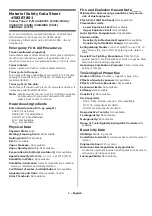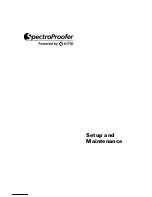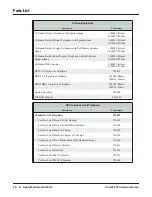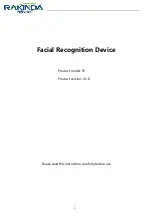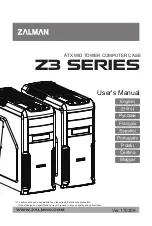
E8
Se le presentará el menú mostrado más abajo; debido a la opción por defecto, se
seleccionará SmartIntercom. Sin embargo, si hay voltaje en la línea sonará un tono de
error. Para comenzar la llamada y llamar al extremo alejado, deslice el interruptor de
modo a la posición HABLA(TALK).
Si está haciendo una llamada SmartIntercom, cuando una unidad distante reconoce el
pedido de llamada usted escuchará un tono normal de "retorno de llamada" a través del
altavoz. Si no hay respuesta de la unidad distante, después de unos segundos se oirá
un zumbido de error.
Las alertas de llamadas SmartIntercom entrantes se recibirán ya sea en los modos
APAGADO (OFF) o MONITOR; usted no tiene que estar en el modo "intercom" para
recibir la señal de alerta. La señal de alerta del intercom (tono de timbre) es un timbre
más agudo con una cadencia más rápida que el normal. Si se escucha esto,
simplemente cambie al modo HABLA(TALK) para responder a la llamada, colocando
automáticamente la unidad PE830 en el modo intercom. Se produce un zumbido de
confirmación para indicar que el modo INTERCOM ahora está activo.
Para salir del modo intercom, simplemente mueva el interruptor de modo desde HABLA
(TALK) a APAGADO (OFF) o a MONITOR. Cuando hace esto, se envía por la línea un
tono de llamada completa para alertar al otro usuario.
7 . I D E N T I F I C ACIÓN DE LLAMADAS (CALLER ID)
En todos los modos, cuando está disponible, visualizará la información CID y CIDCW.
Los mensajes de error se visualizarán cuando se detecta el CID, pero no se recibe por
completo, está corrupto o es de tipo no compatible. (Consulte las Figuras 29 - 30)
8. AURICULAR
Para usar la unidad PE830 "sin manos" simplemente enchufe el auricular suministrado
u otro tipo similar en el receptáculo en la parte superior de la unidad. Esto silenciará
automáticamente el auricular y el micrófono internos. Recuerde que los botones
SILENCIAR (MUTE) y ALTAVOZ (SPEAKER) funcionarán normalmente, por ejemplo,
desactivarán la transmisión cuando se activa.
9. ESPECIFICACIONES
Compatibilidad telefónica:
. . . . . . . . . . . . . . . . . . . . . . TIA/EIA-470-B y ETSI
Temperatura de almacenamiento:
. . . . . . . -10°C (14°F) a +70°C (158°F)
Temperatura de funcionamiento:
. . . . . . . . . 0°C (32°F) a +50°C (122°F)
Humedad:
. . . . . . . . . . . . . . . . . . . . . . . . . . . . . . . . . . . . . . . . . . . . . hasta el 90%
. . . . . . . . . . . . operando 95% en almacenamiento, ambas sin condensación.
CID y CIDCW:
Todos los tipos FSK incluyendo Bellcore TR-NWT-000030 (GR30)
SR-TSV-002476 y ETSI
Duración de la batería:
Más de tres meses de uso típico; menos de 40uA en
el modo APAGADO (OFF) con una vida útil de almacenamiento
con una batería nueva de por lo menos 12 meses. Se recomien-
da que sólo se usen baterías de tipo alcalinas. Siempre es mejor
extraer las baterías antes de almacenar la unidad PE830 durante
períodos largos de tiempo.
Límites de lazo (a 48V):
Resistencia:. . . . . . . . . . . . . . . . . . . . . . . . . . . . . . . . . . . . . . . . . . . . . . . . . . . >5 k
Corriente mínima: . . . . . . . . . . . . . . . . . . . . . . . . . . . . . . . . . . . . . . . . . . . <10 mA
Resistencia de CC:
Descolgado: . . . . . . . . . . . . . . . . . . . . . . . . . . . . . . . . . . . . . . . . . . . . . . . . . . <300
Colgado:. . . . . . . . . . . . . . . . . . . . . . . . . . . . . . . . . . . . . . . . . . . . . . . . . . . . >10 M
Impedancia del monitor:
. . . . . . . . . . . . . . . . . . . . . . . . . . . . . . . . . . . >400 k
Fig.29 – Identificación de llamadas (Caller ID)
Fig.30 – Llamada en espera (Call Waiting)
TABLE DES MATIÈRES
1. DESCRIPTION . . . . . . . . . . . . . . . . . . . . . . . . . . . . . . . . . . . . . . .F2
Caractéristiques . . . . . . . . . . . . . . . . . . . . . . . . . . . . . . . . . . . . . . . . . . . . . . . . .F2
Spécifications importantes . . . . . . . . . . . . . . . . . . . . . . . . . . . . . . . . . . . . . . . . .F2
2. RÉGLAGE DE L'APPAREIL . . . . . . . . . . . . . . . . . . . . . . . . . . . . . .F2
Installation de la pile . . . . . . . . . . . . . . . . . . . . . . . . . . . . . . . . . . . . . . . . . . . . .F2
Avertissement de pile faible . . . . . . . . . . . . . . . . . . . . . . . . . . . . . . . . . . . . . . . .F3
Réinitialisation . . . . . . . . . . . . . . . . . . . . . . . . . . . . . . . . . . . . . . . . . . . . . . . . . .F3
3. BOUTONS ET SÉLECTEURS . . . . . . . . . . . . . . . . . . . . . . . . . . . .F3
Icônes des modes de fonctionnement . . . . . . . . . . . . . . . . . . . . . . . . . . . . . . . .F3
4. MODES DE FONCTIONNEMENT . . . . . . . . . . . . . . . . . . . . . . . . .F4
Mode de réglage . . . . . . . . . . . . . . . . . . . . . . . . . . . . . . . . . . . . . . . . . . . . . . . .
F4
Mode Conversation . . . . . . . . . . . . . . . . . . . . . . . . . . . . . . . . . . . . . . . . . . . . . .
F4
Flash . . . . . . . . . . . . . . . . . . . . . . . . . . . . . . . . . . . . . . . . . . . . . . . . . . . . . . . .F4
Composition hors ligne et recomposition automatique du dernier numéro d'appelant . .F4
Pause . . . . . . . . . . . . . . . . . . . . . . . . . . . . . . . . . . . . . . . . . . . . . . . . . . . . . . .F4
Option de composition par impulsion . . . . . . . . . . . . . . . . . . . . . . . . . . . . . . .F5
Mesure du courant . . . . . . . . . . . . . . . . . . . . . . . . . . . . . . . . . . . . . . . . . . . . .F5
Protection de surintensité . . . . . . . . . . . . . . . . . . . . . . . . . . . . . . . . . . . . . . . .F5
SmartMute
MD
(Coupure Micro) . . . . . . . . . . . . . . . . . . . . . . . . . . . . . . . . . . . . .F5
Haut-parleur . . . . . . . . . . . . . . . . . . . . . . . . . . . . . . . . . . . . . . . . . . . . . . . . . .F5
Mode Écoute discrète . . . . . . . . . . . . . . . . . . . . . . . . . . . . . . . . . . . . . . . . . . . .
F5
Avertissement de surtension . . . . . . . . . . . . . . . . . . . . . . . . . . . . . . . . . . . . . .F5
Avertissement de tension élevée . . . . . . . . . . . . . . . . . . . . . . . . . . . . . . . . . . .
F6
Mode Éteint . . . . . . . . . . . . . . . . . . . . . . . . . . . . . . . . . . . . . . . . . . . . . . . . . . . .F6
Réponse à un appel entrant . . . . . . . . . . . . . . . . . . . . . . . . . . . . . . . . . . . . . . .F6
Arrêt automatique . . . . . . . . . . . . . . . . . . . . . . . . . . . . . . . . . . . . . . . . . . . . . . .F6
5. FONCTIONS DE MÉMOIRE . . . . . . . . . . . . . . . . . . . . . . . . . . . . .F6
Recomposition du dernier numéro . . . . . . . . . . . . . . . . . . . . . . . . . . . . . . . . . .F6
Sauvegarde du numéro de composition rapide . . . . . . . . . . . . . . . . . . . . . . . .F7
Rappel du numéro de composition rapide . . . . . . . . . . . . . . . . . . . . . . . . . . . .F7
6. MODE INTERCOM (PILE LOCALE) . . . . . . . . . . . . . . . . . . . . . . . .F7
7. IDENTIFICATION DE L'APPELANT . . . . . . . . . . . . . . . . . . . . . . .F8
8. CASQUE D'ÉCOUTE . . . . . . . . . . . . . . . . . . . . . . . . . . . . . . . . . . .F8
9. SPÉCIFICATIONS . . . . . . . . . . . . . . . . . . . . . . . . . . . . . . . . . .F8-F9
10. GLOSSAIRE . . . . . . . . . . . . . . . . . . . . . . . . . . . . . . . . . . . . . . . . .F9
Garantie limitée d'un an . . . . . . . . . . . . . . . . . . . . . . . . . . . . . .F10
INDEX DES
ILLUSTRATIONS
Fig. 1 - Sélecteur de mode . . . . . . . . .F3
Fig. 2 - Sélecteur de volume et sourdine .F3
Fig. 3 - Clavier principal . . . . . . . . . . .F3
Fig. 4 - Menu de réglage principal . . .F3
Fig. 5 - Choix de langue . . . . . . . . . . .F3
Fig. 6 - Paramètres de composition . .F4
Fig. 7 - Niveau DTMF . . . . . . . . . . . . .F4
Fig. 8 - Réglage Flash . . . . . . . . . . . .F4
Fig. 9 - Rapport d'impulsions . . . . . . .F4
Fig. 10 - Réglage de tonalité . . . . . . . . .F4
Fig. 11 - Réglage du contraste . . . . . . .F4
Fig. 12 - Flash . . . . . . . . . . . . . . . . . . . .F4
Fig. 13 - Composition par impulsion . . .F5
Fig. 14 - Surintensité . . . . . . . . . . . . . . .F5
Fig. 15 - Mode Écoute discrète . . . . . . . .F5
Fig. 16 - Surtension . . . . . . . . . . . . . . . .F5
Fig. 17 - Mode ÉTEINT . . . . . . . . . . . . .F6
Fig. 18 - Croisement avec ligne électrique .F6
Fig. 19 - Recomposition automatique .
du dernier numéro . . . . . . . . .F6
Fig. 20 - Écran de stockage mémoire 1 . .F7
Fig. 21 - Écran de stockage mémoire 2 .F7
Fig. 22 - Écran de stockage mémoire 3 .F7
Fig. 23 - Écran de rappel 1 . . . . . . . . . .F7
Fig. 24 - Écran de rappel 2 . . . . . . . . . .F7
Fig. 25 - Écran de rappel 3 . . . . . . . . . .F7
Fig. 26 - Intercom 1 . . . . . . . . . . . . . . . .F7
Fig. 27 - Intercom 2 . . . . . . . . . . . . . . . .F7
Fig. 28 - Intercom 3 . . . . . . . . . . . . . . . .F7
Fig. 29 - Identification de l'appelant . . .10
Fig. 30 - Appel en attente . . . . . . . . . . .10




























